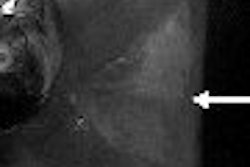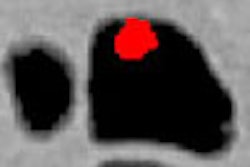One of the largest virtual/optical colonoscopy studies to date found comparable detection rates for advanced adenomas between the two exams in two different but demographically similar patient groups referred by the same primary care providers.
The study, from the department of radiology and the section of gastroenterology and hepatology at the University of Wisconsin Medical School in Madison, appears in the October 4 issue of the New England Journal of Medicine.
Because most of the 6,283 subjects in the two groups lacked clinically significant colorectal findings that would have necessitated the use of colonoscopy for removal, the results suggest that less invasive virtual colonoscopy might be preferable for colorectal cancer screening in an asymptomatic population, wrote study authors Drs. David Kim, Perry Pickhardt, Andrew Taylor, and colleagues.
"Most subcentimeter polyps are not adenomatous, and only a small fraction of all adenomas are advanced, suggesting a need for more selective alternatives to the practice of universal polypectomy," they wrote. "The purpose of this study was to compare computed tomographic colonography (CTC or virtual colonoscopy [VC]) and optical colonoscopy (OC) when applied to the general screening population (NEJM, October 4, 2007, Vol. 357:14, pp. 1403-1412).
Outcome measures of the study included detection rates for advanced adenomas and adenocarcinomas, as well as polyp size categories and overall polypectomy rates in the two exams. These findings were used to assess CTC as a "selective filter for therapeutic optical colonoscopy" in detecting advanced adenomas, the group wrote.
The study compared primary virtual colonoscopy screening in 3,120 consecutive adults (mean SD age 57.0 ± 7.2 years) with primary OC screening in another group of 3,163 consecutive adults (mean age 58.1 ± 7.8 years).
The parallel VC and OC screening programs "drew patients from the same general screening population and geographic region," over a period of 17 and 25 months, respectively, the group wrote. Subjects were excluded for a history of polyp surveillance or a bowel disorder. Most were asymptomatic. Polyps 1 cm or larger were classified as large, 6-9 mm as small, 5 mm or smaller as diminutive, and their morphology characterized as sessile, pedunculated, or flat. Adenomas were classified histologically by subtypes as tubular, tubulovillous (25% to 75% villous component), villous, or serrated.
VC screening included a cathartic bowel prep (usually magnesium citrate but occasionally polyethylene glycol), along with oral contrast tagging agents, including 2% barium (250 mL) and diatrozoate (60 mL). Colonic distension was achieved with automated CO2 insufflation (ProtoCO2l, E-Z-EM, Lake Success, NY). Prone and supine images were acquired on either an eight- or 16-detector-row scanner (LightSpeed series, GE Healthcare, Chalfont St. Giles, U.K.), and examined on a dedicated 3D workstation (V3D Colon, Viatronix, Stony Brook, NY).
Optical colonoscopy was performed by experienced gastroenterologists after bowel cleansing, usually with polyethylene glycol. When colonoscopy subjects were referred from VC, gastroenterologists had knowledge of the findings. Generally, all detected polyps, including diminutive findings, were removed during colonoscopy.
The researchers measured the prevalence of high-grade dysplasia, invasive adenocarcinoma, and overall advanced neoplasia in each study group and for various polyp size thresholds. Referral for colonoscopy and polypectomy was offered to all subjects with a polyp at least 6 mm in diameter, although subjects with one or two subcentimeter lesions at VC were given the opportunity to opt for short-term VC surveillance instead.
According to the results of VC and OC screening, "123 and 121 advanced neoplasms were found, including 14 and four invasive cancers, respectively," and eight and seven high-grade dysplasias, respectively, Kim and colleagues wrote.
"The referral rate for OC in the primary CTC screening group was 7.9% (246 of 3,120 patients). Advanced neoplasia was confirmed in 100 of the 3,120 patients in the CTC group (3.2%) and 107 of the 3,163 patients in the OC group (3.4%), not including 158 patients with 193 unresected CTC-detected polyps of 6 to 9 mm who were undergoing surveillance," they wrote.
A total of 2,434 polyps were removed in the OC group, while the VC subjects referred for OC had a total of 561 polyps removed. Complications included seven perforations in the OC group, four of which had to be repaired surgically. No complications were found in the VC group.
Tubular and tubulovillous histologies were common among the advanced adenomas from primary VC and OC (n = 103 findings ≥ 1 cm for each exam type), while villous and serrated histological characteristics were comparatively rarer for VC (n = 4 for each) and OC (n = 2 for each). There were 12 flat lesions detected at VC compared to just two at OC, the group reported.
Commenting on the divergent number of flat lesions found in the two cohorts, study co-author Dr. Perry Pickhardt told AuntMinnie.com that it was "an unexpected finding -- either they aren't detecting as many flat lesions at OC, or they aren't categorizing them as such."
"Regardless, flat lesions are quite uncommon in our screening population, regardless of technique, and do not appear to be a major issue. One finding I can't explain is why we detected more cancers at CTC, except to say that CTC may be more sensitive for initial cancer detection," he stated.
The overall prevalence of advanced neoplasia among all participants was 3.3%, somewhat lower than the 4% to 6% reported in other studies of healthy screening subjects, and "substantially lower" than the 10.5% prevalence found in a cohort of healthy male veterans, the authors wrote.
"These differences are probably multifactorial, but differences in age, sex, ethnic background, family history, and frequency of symptoms may all play a role," they wrote. The frequency of advanced neoplasia in the study was also lower than has been reported in previous studies.
While polyps 1 mm or larger represent an important screening target that all agree should be removed, more controversial was the radiologists' clinical management of subjects with two or fewer polyps 6-9-mm in size, who were offered short-term VC surveillance. While there are potential benefits in the decreased use of resources and reduced procedural risks, the group wrote, potential drawbacks "mainly involve the possibility of following a polyp that harbors a focus of cancer or transforms to cancer during the surveillance period, resulting in a lost opportunity for cancer prevention."
Nevertheless, the low prevalence of submillimeter lesions harboring high-grade dysplasia and the results of previous longitudinal studies support the practice of short-term follow-up, they wrote. And the diagnostic yields were similar at VC and OC despite the fact that lesions 5 mm and smaller were not reported at VC.
"A major limitation of our study was the lack of randomization," they wrote. "Thus, a potential exists for selection bias affecting the composition of the study population for each program, leading to different prevalences of advanced adenomas." Still, the groups were similar in many respects, they noted, including their young age and predominance of women -- two strong predictive factors in the prevalence of adenomas and high-grade dysplasia.
The similar detection rates for advanced lesions between the two methods is important, because advanced adenoma removal is the target of screening and cancer prevention, Kim and his colleagues wrote.
"The marked decrease in the use of OC and the total rates of polypectomies in the CTC group suggests that this technique is a safe, clinically effective, and cost-effective filter for therapeutic OC," they concluded. By combining the two screening efforts and letting patients choose their preferred method, "the overall screening compliance for total colonic examination could substantially increase," they wrote.
By Eric Barnes
AuntMinnie.com staff writer
October 4, 2007
Related Reading
ACRIN trial shows VC ready for widespread use, September 28, 2007
Study: primary 3D VC equivalent to colonoscopy, September 12, 2007
Gastroenterologists plan to perform VC, January 25, 2007
Polyp surveillance risk may be acceptably low, October 17, 2007
New data reveal higher efficacy for primary VC screening, October 18, 2006
VC finds risky polyps, might reduce polypectomies, June 8, 2006
Copyright © 2007 AuntMinnie.com



















